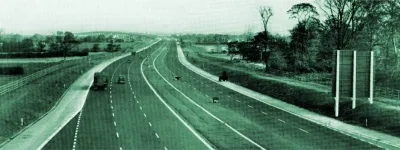With the Pelican established, the history of the pedestrian crossing's development is mostly finished. But it would be a terrible shame to stop without mentioning what can only be described as a completely baffling idea that was raised more recently.
It came about because the Greater London Council (GLC) was looking for ways to get more efficient performance from its signalised junctions. More efficiency meant more time on green lights and less time where the chaotic London traffic was held up. A set of holiday photographs from a trip to Spain held on government file show that one of the Council's traffic engineers had seen something there that he thought could be the answer. It became known as the Flashing Amber Arrow experiment.

The concept was quite simple, and was borrowed wholesale from systems that have operated for many years in other European countries. The GLC wanted more of its junctions to include pedestrian crossing facilities, but these used up valuable green-light time. On junctions that already had crossing facilities built-in, the crossings were useful but for most of the time there were only a couple of people crossing and holding up all the traffic. The solution was to allow motorists to use the junction during the pedestrian phase, as long as they gave priority to anybody crossing the road. It was supposed to work in the same way as the flashing amber phase on Pelican crossings.
The initial proposal was for pedestrians to be able to cross to the left or right of the traffic currently seeing a green light. To begin with, they would see a green man, and motorists would see a red light and an 'ahead only' green arrow, preventing any turns. The green man would then be extinguished and no pedestrian lights would show, with motorists now seeing a full green light and a flashing amber left-turn light. They could now turn, but had to give way to anybody still on the crossing. As a reminder, a flashing amber man signal was to be placed on a traffic island, visible to left-turning traffic. Afterwards, the red man would return, and traffic would just see a full green light.
The GLC's traffic engineers knew it would save valuable time on the traffic light cycle, but it had the slight downside of being a deathtrap for the innocent pedestrian. The warning that cars might start bearing down on you as you crossed came only in the form of both pedestrian lights being turned off. As for the hapless driver, a flashing amber arrow and a flashing amber man would accurately convey the message that something strange was going on, but not much more. And therein was the biggest problem with the Flashing Amber Arrow experiment: there was no way to quickly tell motorists what was expected of them.

The idea was bounced around the GLC for years, and in discussions with the Department of Transport it found favour in principle. Test sites were selected at Southwark and Harrow. Draft wordings of road signs to describe the horrors of the experiment to motorists were drawn up (and annotated in pencil with a warning not to show the diagrams to the GLC's traffic department or they would be "made up before we know where we are"). While the idea would bring the UK into line with Europe and the USA, where either flashing amber lights or a simple "right on red" rule did much the same thing, it was noted with some hesitation that laws already existed asking motorists to give way to pedestrians when turning in to a side road. If those rules were mostly overlooked, what hope did this stand?
The initial idea — to turn off the pedestrian lights and then let drivers plough through the last part of the crossing phase — was refined. By 1985, the concept was finalised and it was a little different. Instead of giving pedestrians a green man crossing phase, the lights would simply show them the safest part of the traffic light cycle to cross the road, during which time traffic would be required to give them priority. It did this by showing a red man to pedestrians when it wasn't safe and then, at the best time in the sequence for them to cross, this changed to a flashing amber man. Motorists turning in to that arm of the junction would be faced with a flashing amber light, intended to be reminiscent of a Belisha Beacon. Where the pedestrian phase was to one side, an amber arrow was to be used as a warning that pedestrians were crossing out of sight.

By September 1985, the GLC was all set to try the idea out on the roads. It had leaflets designed (running to several pages to fit in all the details of the complex idea) and settled on the wording of the warning signs. Communication was made with the Department of Transport to obtain clearance.
On 9 September 1985, the memo came back from Whitehall. In light of the complexity of the new traffic light system, and the difficulty that there would be in explaining it, and the risk of motorists misunderstanding the concept and causing an accident involving a pedestrian, it was just too risky. The plan had arrived on the desk of Lynda Chalker, the Minister of State for Transport, and she had said "no". With that, the GLC decided not to put any more effort in to making it work, and unceremoniously binned the idea, closing the Flashing Amber Arrow file for good. There was no need to take it so personally.
